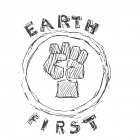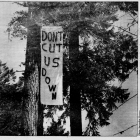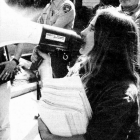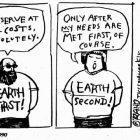The Second Decade (1990-2000)
By the late 1980s, some of those with differing, and more overtly anarchistic perspectives than Foreman, who controlled the journal through the 1980s, began publishing their own tabloids. Among these were Live Wild or Die!, which was orchestrated foremost by M. J., one of the movements’ best known Northwestern forest defenders, and ALARM, which was orchestrated by two other longstanding and important Earth First! activists, Anne Peterman and Orin Langelle, and published in the Northeastern U.S. Many issues from these magazines appear in this print history.
The original exhibition includes and interactive gallery of the journals Live Wild or Die!, ALARM, and Wild Earth. View the items on the following pages.
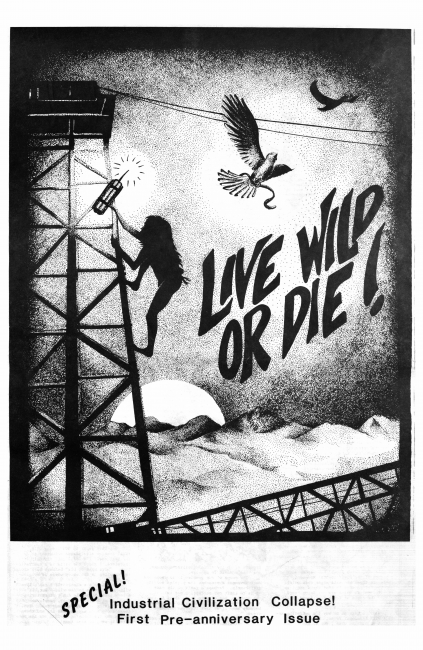
Live Wild or Die! no. 1, Front Page
This is not an “Environmentalist” newspaper. Environmentalism is the political ideology which places bureaucratic band-aids on the industrial cancer. Environmentalism is single-issue Liberal politics divorced from the ensemble of life. This is not even a “radical environmentalist” paper! We need to re-invent the world, not re-label it.
— Editorial introduction to Live Wild or Die, no. 1
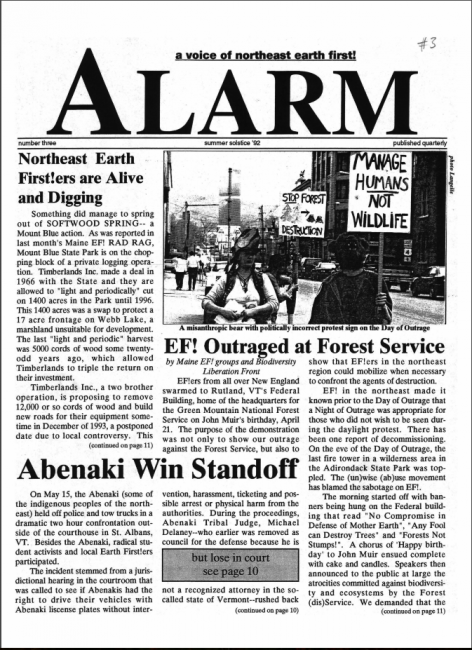
ALARM no. 3, Front Page
We are publishing this journal for various reasons. One is to document activities in our region while presenting an Earth First! vision for the northeast that hopefully can be used as an educational tool to empower people to take direct action. Another important reason is that we feel we have to.
— Orin Langelle
See ALARM no. 3
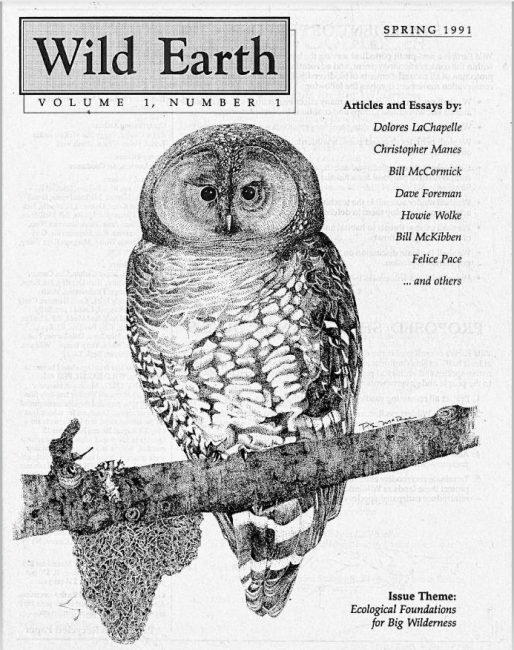
Wild Earth 1, no. 1, Front Page
If you like the talk and the company around this campfire, join us. Sit down and share your ideas. But if this campfire doesn’t feel like home to you, please look for another one. There are lots of good groups out there. Wild Earth is not for everyone. We are conservationists. We believe in wilderness for its own sake. With John Muir, we are on the side of the bears in the war industrial humans have declared against wild nature.
— Dave Foreman

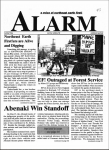

The journals Live Wild or Die!, ALARM, and Wild Earth. Click on the images for a larger format.
The movement, made fragile from internal divisions and external repression, did not survive intact for long after the arrests of Foreman and the bombing of Bari and Cherney. After the bombing, some activists withdrew out of fear that they might be targeted by vigilantes or framed by law enforcement authorities. Foreman and those closest to him felt unsupported by the wider movement in their precarious situation as they faced trial, and moreover, thought that the movement had lost its moorings with its increasingly diverse array of concerns and passions. He and his closest associates withdrew from the movement before or by the end of its first decade, leaving the movement in crisis at the beginning of the 1990s. (Foreman went on to establish and publish Wild Earth (1991–2004) which took a strong biocentric perspective deeply informed by conservation biology.)
After a brief period in the early 1990s wherein Earth First! co-founder Mike Roselle was installed as lead editor of the movement’s journal but was viewed as too authoritarian in his editorial style by some activists, a new, collective structure was established to publish Earth First! The journal’s new structure reflected the growing proportion of anarchists in the post-schism movement. The issues addressed in the journal grew dramatically to include a host of causes that had gotten relatively little attention during the 1980s, including animal liberation and the support of Animal Liberation Front (ALF) prisoners. It also focused increasing attention on egalitarian ideals, advancing many anti-capitalist, anti-racist and anti-sexist causes, and engaging in much internal critique of the movement’s failures to consistently reflect and promote these values.

This Earth First! Journal issue included an introduction to the Earth Liberation Front, an offshoot of Earth First! that emerged in 1992. See Earth First! Journal 13, no. 8. Click on the image for a larger format.
This Earth First! Journal issue included an introduction to the Earth Liberation Front, an offshoot of Earth First! that emerged in 1992. See Earth First! Journal 13, no. 8. Click on the image for a larger format.
© Earth First! Journal
The copyright holder reserves, or holds for their own use, all the rights provided by copyright law, such as distribution, performance, and creation of derivative works.
Perhaps most significantly, the journal’s pages increasingly discussed (most would say at least implicitly endorsing) increasingly radical tactics, including arson. Its pages also sympathetically covered the groups becoming infamous for such tactics, including the Animal Liberation Front and the Earth Liberation Front (ELF, an offshoot from Earth First! in the United Kingdom in 1992 by activists frustrated by the movement’s absolute commitment to non-violence).
Noting this radicalization, the so-called Unabomber, Theodore John Kaczynski, wrote to a journal editor expressing appreciation for an article she wrote endorsing arson. (Kaczynski had waged a murderous mail-bomb campaign against those he considered representatives of an authoritarian and environmentally destructive technological civilization before he was arrested and convicted on multiple bomb-related charges and for three murders, and subsequently sentenced to life in prison in 1998.) Kaczynski had his sympathizers in the radical environmental movement, but great controversy arose about whether the journal should publish his letter or a prison interview that this editor eventually conducted with him.
Many movement activists rejected his violent tactics and did not want the movement tarred by them. But the explicit and implicit endorsement of the ALF and ELF, the sympathy of some for Kaczynski, and the focus on issues that some in the movement considered to be mired in distracting, anthropocentric concerns, caused more moderate members of the movement to drift away. The result was an increasingly radical and anarchistic movement.
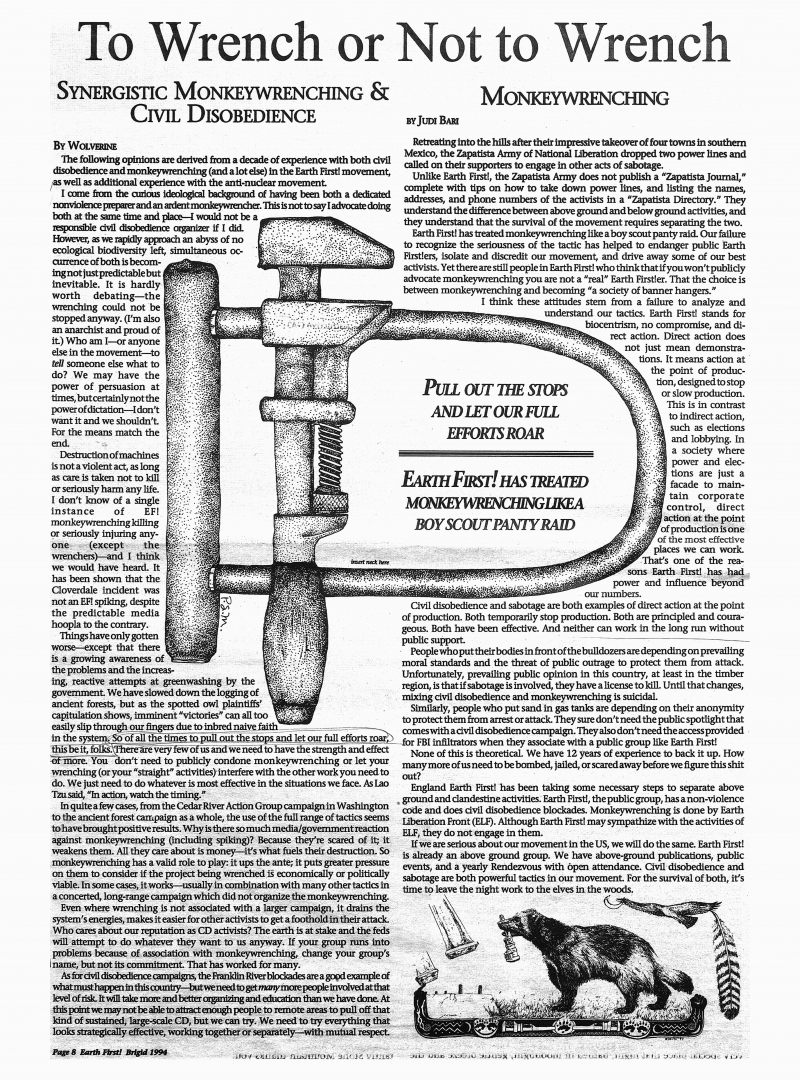
Following the bombing of her car, Judi Bari wrote an article asserting that Earth First! should be responsible for non-violent actions while violent actions should be left to underground groups like the Earth Liberation Front (ELF). See Earth First! Journal 14, no. 3.
Following the bombing of her car, Judi Bari wrote an article asserting that Earth First! should be responsible for non-violent actions while violent actions should be left to underground groups like the Earth Liberation Front (ELF). See Earth First! Journal 14, no. 3.
© Earth First! Journal
The copyright holder reserves, or holds for their own use, all the rights provided by copyright law, such as distribution, performance, and creation of derivative works.
Throughout the 1990s Earth First!’s campaigns primarily involved protests, lawsuits, and civil disobedience. In several cases, the resistance gained enough strength to orchestrate large protests that included mass protest arrests, as in 1996 when thousands of citizens gathered in a sparsely populated area of northern California to protest logging in ancient redwood groves by the Pacific Lumber Company (PALCO); over a thousand citizens were arrested. This and a decade of resistance to PALCO’s practices contributed to political pressures to reduce social disruption and the loss of political support, and led to heightened scrutiny by state forest authorities and to the company being cited repeatedly for violating the law. Eventually, a deal was worked out wherein the company would sell the most biologically precious old-growth groves to the state of California. Not long afterward the company went bankrupt and was sold to another company with a better reputation, which promised to protect the remaining ancient groves and manage the rest of its forestland more gently.
In another long struggle, Earth First! and other environmental activists worked in solidarity with religiously traditional American Indians opposed to a complex of telescopes being built (with more planned) on Mount Graham in southeastern Arizona. In their own ways both the Indian and environmental activists viewed the mountain as sacred, either as a place of ceremony and prayer necessary to communicate with their gods, on the one hand, or as a sacred island ecosystem populated by precious, endangered species. Although they did not prevent the construction of three telescopes, they did thwart the construction of eight others.
The original exhibition includes an interactive timeline of stories from Mount Graham and from the resistance to PALCO’s practices in Headwaters Forest. View the images on the following pages.
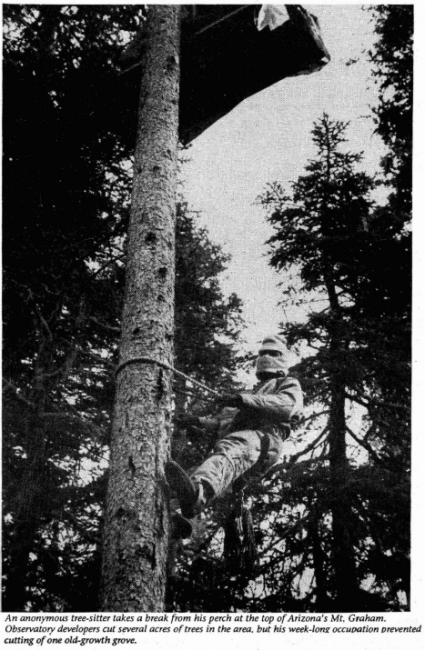
Anonymous Tree-Sitter
On Friday 28 September 1990, the 9th Circuit Court of Appeals drew back its previous decision to halt the preparatory work for the University of Arizona’s construction of three telescopes on Mt. Graham in southern Arizona. This decision allowed the University to cut down trees and clear the telescope sites with an immediate effect.
As the trucks began to roll, the ecowarriors, even those in handcuffs, threw their bodies in front of them. […] The fight for Mt. Graham continues.
— Jim Leonard

Pacific Lumber Banner
After eight years of direct action, public demonstrations, court battles, ballot initiatives, and legislative efforts were culminating in a promising bill to protect vast areas of the redwood ecosystem. The Headwaters Forest in northern California were at the core of this wilderness bill. The banner is calling on Pacific Lumber to relinquish its territory of redwoods, which was planned for logging.
Earth First! staged protests to awaken the public to the plight of the redwoods. […] May the ancient trees of Headwaters forever stand tall!
— Unknown
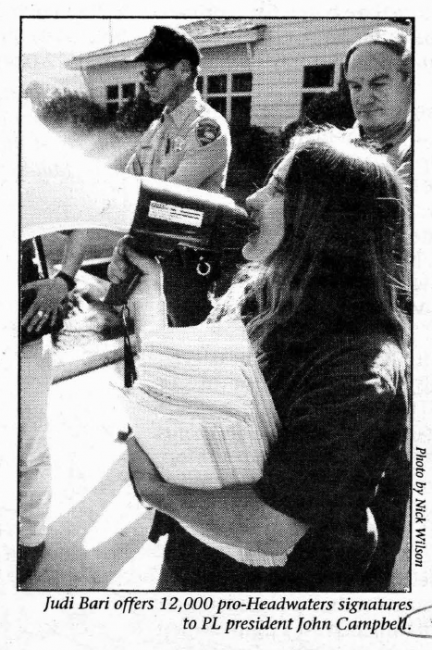
Judi Bari
Judi Bari handed over 12,000 signatures urging the Pacific Lumber’s president to save Headwaters Forest.
Well, we did it! In the face of a swift and impressive mobilization of community outrage, Maxxam/Pacific Lumber (PL) backed down and signed an agreement on March 28 to delay their logging deadline for Headwaters Forest.
— Judi Bari
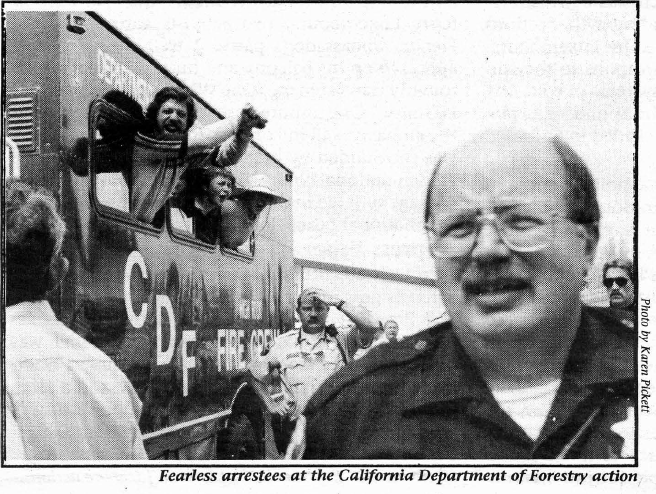
Arrested Earth First! Members
Earth First! members were arrested after occupying the California Department of Forestry in protest against the logging plans for the Headwaters Forest.
Support people helped a blockader lock himself to the steering column in the Chevy while two others locked to other parts of the body. Click, click, click. Two more people secured themselves to the gate. Another gate was buried in three feet of rubble.
— Karen Pickett

Mass Action for Headwaters
This photo was taken during a mass action for Headwaters on 15 September 1995. Of the 2000 participants, 264 were arrested.
The September 15 rally included people from many walks of life: urban Food not Bombers, grandmothers, timber workers, toddlers, local housewives and dreadlocked hippies.
— Randy Ghent
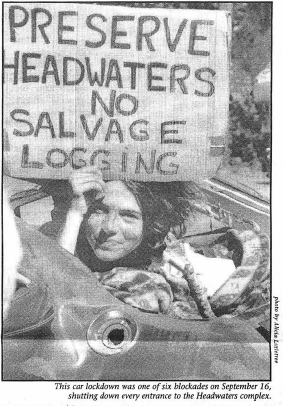
Save the Headwaters Forest
This photo was taken during the protest against Pacific Lumber on 16 September 1996. An estimated 1,000 out of 8,000 protesters were arrested in what was a record-breaking protest at the time.
In a stunning display of cluelessness, PL [Pacific Lumber] began dragging ancient trees out of All Species Grove on the day before the Board meeting. Suddenly, any remaining public illusions about the deal evaporated, and Feinstein and Garamendi spent the day stammering into the cameras with rotten egg on their faces.
— Hugh Morose
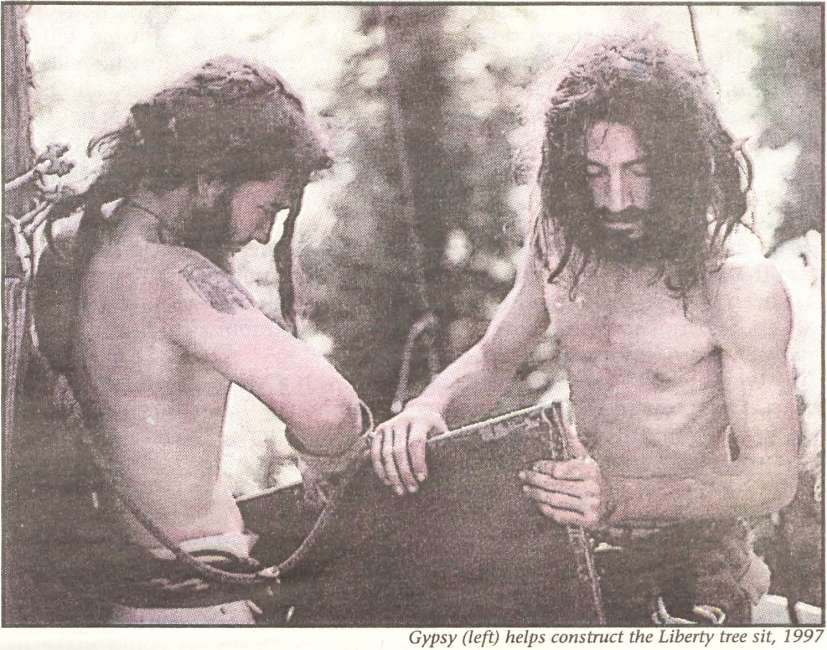
EF! Activist Killed
David Nathan Chain, known to his friends as “Gypsy,” lost his life on 17 September 1998 when a tree cut by a Pacific Lumber logger crushed him to death.
The fact that the loggers were indeed aware of the protesters’ presence was corroborated by a videotape recorded less than an hour before Chain was killed. It contains threats and admonitions by the logger to “Get the fuck out of here or there’s going to be a tree coming your way!”
— Karen Pickett

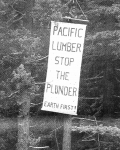
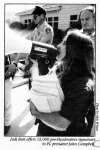


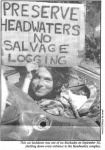
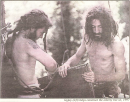
Stories from Mount Graham and from the resistance to PALCO’s practices in Headwaters Forest. Click on the images for a larger format.
Often complemented by lawsuits, the radical environmental movement had no small number of victories in the 1990s, although the victories were usually small. Nevertheless, the perception of the movement’s activists was that they were losing overall and badly, and moreover, that the government was not only corrupt and in cahoots with industry, but increasingly repressive. Such perceptions reinforced an increasingly common view in the movement that the time had come to eschew above-ground tactics and create an underground resistance movement. By the mid-1990s there was a proliferation of such tactics. Between then and the terrorist attacks on the World Trade Center in 2001, at least twenty activists deployed arson as a tactic—torching gas-guzzling sport utility vehicles, a ski lodge being built in the habitat of a threatened species of Canadian Lynx in Colorado, a Forest Service office in Oregon, a university research station believed to be investigating the genetic modification of organisms in Washington, and “trophy homes” being built in ecologically sensitive areas—to name but a few of these incendiary incidents.
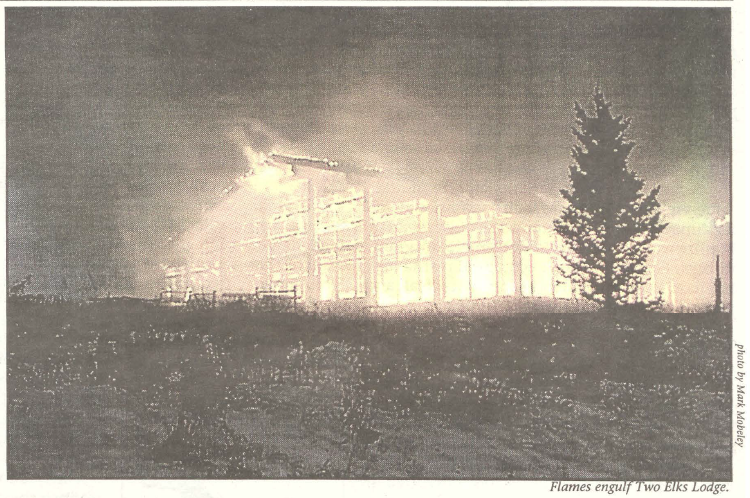
On the night of 18 October 1998, members of the Earth Liberation Front set fire to the Two Elks Lodge in Vail, Colorado. This action resulted in minimum damages of more than $12 million to Vail Associates, making it one of the most expensive acts of environmental sabotage to date. The fires were set five days after a decision to allow the Vail Associates’ planned expansion into the Two Elk Roadless Area. See Earth First! Journal 19, no. 2.
On the night of 18 October 1998, members of the Earth Liberation Front set fire to the Two Elks Lodge in Vail, Colorado. This action resulted in minimum damages of more than $12 million to Vail Associates, making it one of the most expensive acts of environmental sabotage to date. The fires were set five days after a decision to allow the Vail Associates’ planned expansion into the Two Elk Roadless Area. See Earth First! Journal 19, no. 2.
© 1983 Mark Mobley
The copyright holder reserves, or holds for their own use, all the rights provided by copyright law, such as distribution, performance, and creation of derivative works.




